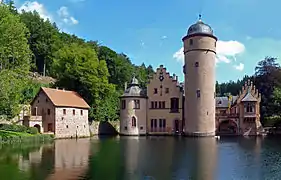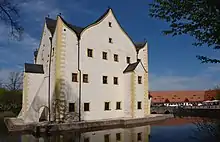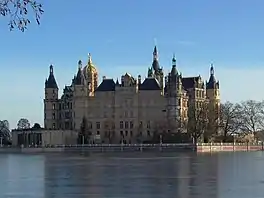Water castle
A water castle, sometimes water-castle,[lower-alpha 1] is a castle where natural or artificial water is part of its defences.[2][3] (It can be entirely surrounded by water-filled moats (moated castle) or natural waterbodies such as island castles in a river or offshore. The term comes from European castle studies, mainly German Burgenkunde.[4][5][6] When stately homes were built in such a location, or a Wasserburg was later rebuilt as a residential manor, the German term becomes Wasserschloss, lit. "water palace/manor".



Description
Forde-Johnston describes such a site as "a castle in which water plays a prominent part in the defences."[2] Apart from hindering attackers, an abundant supply of water was also an advantage during a siege. Topographically, such structures are a type of low-lying castle. Such a castle usually had only one entrance, which was via a drawbridge and that could be raised for protection in the event of an attack. To some extent these water castles had a fortress-like character.
There is a further distinction between:
- castles that are protected by artificial water-filled moats or man-made ponds, i.e. moated castles
- castles whose primary means of protection is from natural water bodies such as river courses, or which stand on islands or peninsulas in a natural marshland, pond, lake or sea. Island castles and marsh castles are such examples.
Legacy
In many places in Central Europe castles that had formerly been fortified changed their role or were converted over the course of time so that they became largely representational and residential buildings. The characteristic moats thus lost their original security function, but were retained in some cases as an element of landscaping. Today, in monument conservation circles, they are often described as burdensome, cost-intensive "historic legacies" because of the water damage caused to their foundations. As a result, many moats around castles in Germany have been drained, or more rarely filled, especially since the 1960s.
In Germany, the Wasserburgroute or "Water Castle Route" has been established in the triangle formed by the cities of Aachen, Bonn and Cologne which links 120 castles and palaces.[7][8]
Examples
Austria
Czech Republic
- Blatná Castle
- Červená Lhota Castle
- Švihov Castle
Denmark
Finland
France
Please notice that in French "château d'eau", literally 'water castle', means water tower.
Germany




Baden-Württemberg
- Bad Rappenau Water Castle
- Inzlingen Castle
Berlin
Brandenburg
- Plattenburg in the Prignitz
Bremen
- Blomendal Castle
- Schönebeck Palace
Hamburg
- Bergedorf Palace
Hesse
- Friedewald Water Castle in Friedewald
- Fürstenau Palace near Steinbach
Lower Saxony
Mecklenburg-Vorpommern
North Rhine-Westphalia
- Benrath House in Düsseldorf
- Burgau Castle
- Darfeld Castle
- Gimborn Castle
- Haus Kemnade in Bochum
- Morsbroich Castle in Leverkusen
- Moyland Castle in Bedburg-Hau
- Nordkirchen Palace
- Rheydt Palace
- Dyck Palace
- Vischering Castle
- Wilkinghege Water Castle in Münster
- Wittringen Castle in Gladbeck
- Lembeck Castle
Rhineland-Palatinate
- Alte Burg (Boppard)
- Alte Burg (Koblenz)
Saarland
- Gustavsburg in Homburg
- Kerpen Castle near Illingen
Schleswig-Holstein
Thuringia
- Kapellendorf Water Castle
Greece
Hungary
- Sárvár Castle
- Tokaj Castle (ruined)
Indonesia
Italy
- Castello Estense
- Castello di Sirmione
- in a broad way, Venice Arsenal
Lebanon
Netherlands
Portugal
Slovakia
- Parič Castle (ruined)
- Šintava Castle (ruined)
- Štítnik Water Castle
- Vranov Castle (vanished)
Sweden
- Älvsborg Fortress
- Bollerup
- Dybäck Castle
- Ellinge Castle
- Gåsevadholm Castle
- Gripsholm Castle
- Häckeberga Castle
- Hjularyd Castle
- Kalmar Castle
- Krageholm Castle
- Krapperup Castle
- Kronoberg Castle
- Kulla Gunnarstorp Castle
- Landskrona Citadel
- Malmö Castle
- Maltesholm Castle
- Örebro Castle
- Örup Castle
- Osbyholm Castle
- Skabersjö Castle
- Stegeborg Castle
- Strömsholm Palace
- Tosterup Castle
- Trolle-Ljungby Castle
- Trolleholm Castle
- Vadstena Castle
- Vaxholm Fortress
- Vegeholm Castle
- Vibyholm Castle
- Viderup Castle
- Vittskövle Castle
Romania
- Făgăraş Castle
- Oradea fortress
Switzerland
Turkey
- Kızkalesi (castle), formerly Gramvoussa (Greek) and Gorygos (Armenian)
England
Notes
- See e.g. Gothein (2014)[1]
References
Citations
- Gothein (2014), pp. 22, 52, etc.
- Forde-Johnston, James L. (1979). Great Medieval Castles of Britain. Bodley Head. ISBN 978-0-370-30236-2.
- Lepage (2023), p. 331: "Water castle: A medieval castle in which natural or artificial water was part of the defences."
- Kaufmann & Kaufmann (2004), p. 229.
- 12 Wonderful Water Castles at theworldgeography.com. Retrieved 12 March 2021.
- Proceedings of the Suffolk Institute of Archaeology and History (2005), p. 44.
- Water castle route at achen-tourismus.de. Retrieved 12 March 2021.
- Water Castles Route at nrw-tourism.com. Retrieved 12 March 2021.
- Fry, Plantagenet Somerset (1980). The David & Charles Book of Castles. David & Charles. p. 89.
General
- Suffolk Institute of Archaeology and History (2005). Proceedings of the Suffolk Institute of Archaeology and History, Vol. 41, Part 1. Suffolk Institute of Archaeology and History.
- Forde-Johnston, James L. (1979). Great Medieval Castles of Britain. The Bodley Head ISBN 0370302362.
- Fry, Plantagenet Somerset (1996). Castles of Britain and Ireland: The Ultimate Reference Book. David & Charles.
- Gothein, Marie Luise Schroeter and Walter P. Wright (2014). A History of Garden Art. Cambridge: CUP.
- Kaufmann, J. E. and H.W. Kaufmann (2004) The Medieval Fortress: Castles, Forts and Walled Cities of the Middle Ages. Cambridge, MA: Da Capo.
- Lepage, Jean-Denis (2023). Dictionary of Fortifications: An Illustrated Glossary of Castles, Forts and Other Defensive Works from Antiquity to the Present Day. Barnsley, UK and Havertown, PA, USA: Pen & Sword Books.















